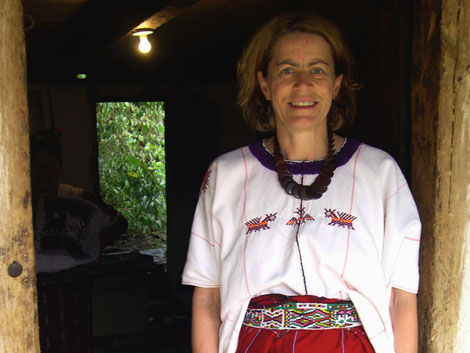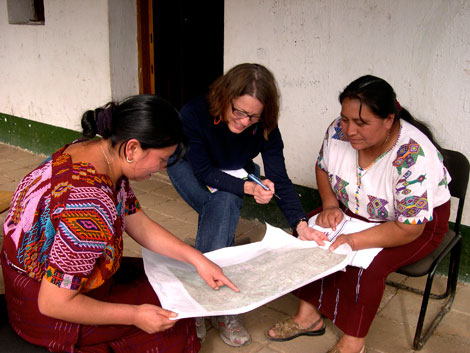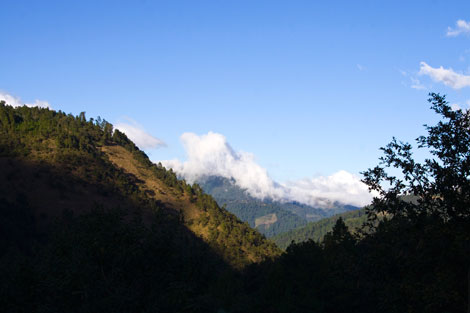 About the Author
About the Author
SUSANNA BADGLEY PLACE draws upon a lifetime of work and travel with U.S. Peace Corps, World Bank, and service-focused non-profit organizations. She first traveled to Guatemala in the early 1990s to study Maya textile traditions and has since become involved in programs to promote educational opportunities and sustainable development in Guatemala. After her first visit to the Ixil Region in 2004, Place has returned every year to deepen her knowledge about these ancient and vibrant Ixil Maya communities.
Local Collaboration
In preparation for an initial visit to the Ixil Region in 2004, I searched guidebooks and scholarly material on the region and the Ixil culture and came up with slim pickings. The leading travel literature carried scant paragraphs about this region, highlighting the “Ixil Triangle” as a major battle theatre during the Guatemalan civil war. The few academic studies of the Ixil Maya revealed a deeply traditional Maya culture still rooted in ancient belief systems and practices. The intricate tapestries of mythical figures populating Ixil backstrap-loom weavings told their own stories of a deeply reverent culture in an intimate harmony with the forces of nature. During my first visit to Nebaj, Chajul, and Cotzal, I was all eyes, ears and questions; after a second visit six months later, I became intrigued with the idea about writing a guide to this extraordinary mountain Maya communities—their ancient cultural heritage, millennial struggle to preserve their identity and lands, and their modern challenges to recover from widespread civil war devastation and commandeer more control over their own futures.
 I tentatively floated this idea about a culture guidebook among the handful of Ixil Maya professionals I had met in recent travels. Such was their enthusiasm for this project that I promptly harvested a talented team with abundant expertise. Juan Clemente Raymundo Velasco of Nebaj, an engineering graduate of the University of San Carlos and former director of the European Union–funded Project Ixil, took the lead in organizing investigations for the guide, interviewing community leaders, and providing analysis of economic and social trends. Ana Laynez, president o f the Association of Maya Ixil Women (ADMI), contributed Ixil Maya oral histories and information on the history, organizations, and traditions within Chajul. Beth Lentz, a former U.S. Peace Corps volunteer in Cotzal, with a Master’s in international relations, documented cultural traditions, education, health, and social issues in Cotzal. Miguel Ceto Raymundo of Nebaj, with a Master’s in social development from the University of Rafael Landívar, supplied details about traditional Ixil religious customs, ancient and modern community authorities, and sensitive land-use and ownership issues.
I tentatively floated this idea about a culture guidebook among the handful of Ixil Maya professionals I had met in recent travels. Such was their enthusiasm for this project that I promptly harvested a talented team with abundant expertise. Juan Clemente Raymundo Velasco of Nebaj, an engineering graduate of the University of San Carlos and former director of the European Union–funded Project Ixil, took the lead in organizing investigations for the guide, interviewing community leaders, and providing analysis of economic and social trends. Ana Laynez, president o f the Association of Maya Ixil Women (ADMI), contributed Ixil Maya oral histories and information on the history, organizations, and traditions within Chajul. Beth Lentz, a former U.S. Peace Corps volunteer in Cotzal, with a Master’s in international relations, documented cultural traditions, education, health, and social issues in Cotzal. Miguel Ceto Raymundo of Nebaj, with a Master’s in social development from the University of Rafael Landívar, supplied details about traditional Ixil religious customs, ancient and modern community authorities, and sensitive land-use and ownership issues.
Together, we crafted a complicate matrix of subjects and the team set out by foot to gather a wealth of information about Ixil Maya culture and places of historic, economic, social, and ecological interest within the diverse and beautiful peaks and valleys of the three Ixil-speaking municipalities. I could not have been more fortunate in this collaboration: members of this team have accompanied me on many explorations, introduced me to many voices in their communities, and enabled me to offer this portrait of the Ixil Maya at this point in their noble history. I cannot thank them enough for their insights and friendship. Out of respect for my hosts’ privacy and for reasons of political and cultural sensitivity, I purposely wrote this guidebook in first-person. The opinions expressed in this book are my own, as are any errors and shortcomings.

